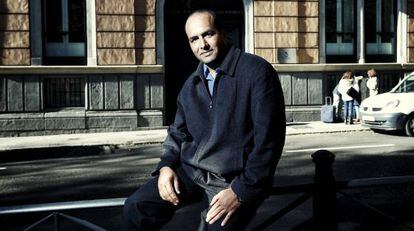“Morocco said my brother was alive; now we have proof they were lying”
Mahmud Selma Daf's 37-year search for his father and sibling led to a desert grave


His mother, Taufa, would wake up screaming at night, until she died in 2010. His five older sisters were "always sad." Mahmud Selma Daf didn't quite understand why until he went to school for the first time aged eight, and saw how the other children were dropped off and picked up by their fathers. Mahmud didn't have one. He started to ask why, and gradually found out where the sadness hanging over his family originated.
"In the beginning they told me my father had gone with the herd and hadn't come back because the journey was very long. When I was 12, they told me a boy had witnessed the execution of two people and had recognized the voice that pleaded for mercy: my father. The other person was my brother. That's when I understood why they were sad." Mahmud, now 41, was four when Moroccan soldiers shot his father and 14-year-old brother in 1976, when the Spanish flag still fluttered over Western Sahara - now a territory claimed by Morocco.
When he returned from Cuba, where he had studied industrial engineering, with a grant from the Polisario Front Sahrawi independence movement and an Algerian passport, Mahmud went to find the boy who had witnessed the killings. "From that moment I hoped to find them," he says.
In February of this year, a shepherd chanced upon human remains in Fadret Leguiaa, in the region of Smara, 400 kilometers from the main refugee camps at Tindouf and less than one from the Moroccan defensive wall. In June, a Spanish team led by forensic investigator Francisco Etxeberria went to the site and uncovered two graves containing the remains of eight people, all of whom had been shot.
I was born under the Spanish flag in Western Sahara: I want Spain to help"
"My sister remembered clearly that my brother was wearing a striped blue jersey on the day he went missing," Mahmud explains. "When I saw it, I started to cry. Paco [Etxeberria] explained it all to us: how they died, in what position they had fallen into the grave, where the bullets had entered, why the cartridges showed they had been killed there... When they confirmed the DNA test results we were sad, but also relieved, because at least we knew for certain that the people we had been awaiting for 37 years were not going to come back."
The DNA analysis also proved that the Moroccan authorities had lied. In September, Mahmud's sister went to the headquarters of the United Nations Working Group on Enforced or Involuntary Disappearances to explain the details of the case. "The UN gave her a document in which the Moroccan government claimed that her brother had not been killed, but had changed his name and was living in [the territorial capital] Laâyoune." But Mahmud had just buried him. "We have demonstrated with scientific proof that they are lying. Morocco should stop toying with our feelings!"
Exteberria's team returned to Morocco last month to hand over the remains of those killed to their families. The bones were wrapped in white cloth and tied according to the Muslim tradition. Several members of Minurso, the United Nations mission in Western Sahara, were at the ceremony. "The act had a very positive effect on us, and also on other families of missing Sahrawis, because they now have hope," says Mahmud. The remains of the eight were interred near the spot where they had lain undiscovered for 37 years, and a marble headstone with their names was erected with a phrase from the Koran inscribed on it: "In memory of the martyrs."
Finding his brother and his father after so long was a "relief." But Mahmud now wants Spain to get involved. "I was born under the Spanish flag. I would like the Spanish justice system to intervene and to find the people responsible. Nobody likes to live with knowledge that the killer of one of your loved ones is walking freely on the street."
Report offers strongest evidence yet of Western Sahara genocide
After the Spanish investigation team had recovered the remains of eight Sahrawis killed by Moroccan forces almost 40 years ago - among them two children - the families decided to seek justice in Spain. "The last Spanish soldier left the Sahara on February 26, 1976, and these executions took place on February 12. The report on this exhumation is the most solid piece of evidence we have," explains Manuel Ollé, the lawyer representing the families who presented a genocide lawsuit in the High Court in 2006.
Magistrate Baltasar Garzón assumed the authority to investigate in 2007 but was later suspended from his post. Judge Pablo Ruz then inherited the case, which remains open.
The report that Ollé has added to the suit, compiled by forensic investigator Francisco Etxeberria and psychologist Carlos Martín Beristain, was written with the methodology of a legal expert; Etxeberria has appeared as a specialist witness in cases such as the deaths of Pablo Neruda and Salvador Allende, the Chilean poet and the former president of the same country, respectively. Beristain has worked with the Inter-American Court of Human Rights and the International Criminal Court.
Ollé expects that the report will serve to give the process impetus and will lead to those responsible being called to court. "This lawsuit concerns torture, forced disappearances, the assassination of entire families, crimes against sexual liberty, the poisoning of wells... These are not ordinary crimes. They have a clear end: to exterminate the Sahrawi people. A genocide. They are crimes that the international community is obliged to pursue," the lawyer said during a conference organized by the Spanish NGO Association Pro Human Rights and the General Council of the State Attorney's Office.
Etxeberria and Beristain presented their findings on September 17 to the director of the Human Rights Office of the Foreign Ministry, Cristina Fraile. "They asked us to send them more photographs of the Spanish national identity cards we recovered from among the bones and we did so the following day, but we haven't heard anything more since then," says Beristain. "We have presented very convincing evidence that requires an answer. Spain should open its own investigation into these events, because these were Spanish citizens and they should ask that the Moroccan authorities cooperate," Beristain adds.
The DNA tests carried out on the remains revealed that Moroccan authorities lied in a report issued by the country's Equality and Reconciliation Commission in 2006, which stated that four of the victims recovered from the desert graves had died in a Smara prison. "Bones can be exhumed, and so can truths. And this has been buried since 1976," says Beristain.
In its last trip to the area where the events took place, the investigative team found three further mass graves. In their report, they said that as many as 400 disappeared Sahrawis may lie within. "We have to go back again, and we hope to be able to do so in six months. For now we have exhausted our resources. When we receive some economic assistance, we'll go back," says Exteberria.










































